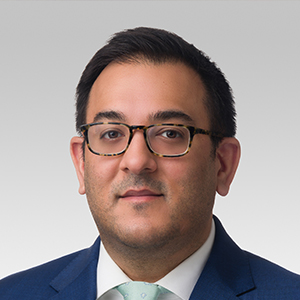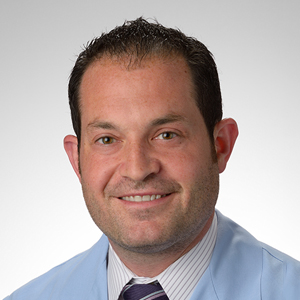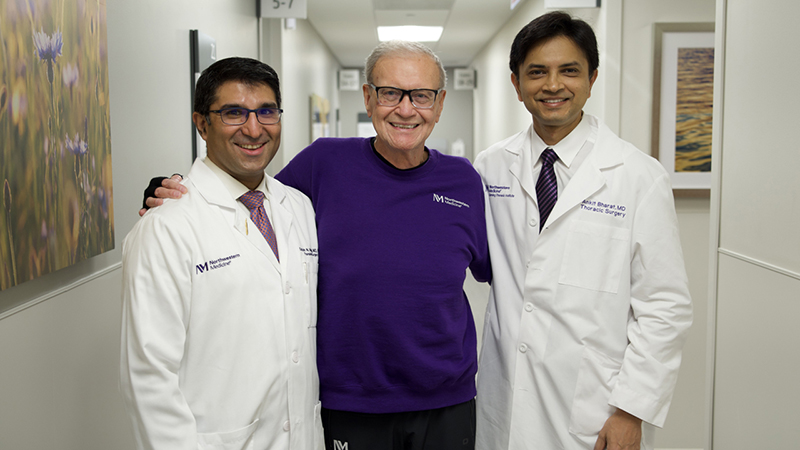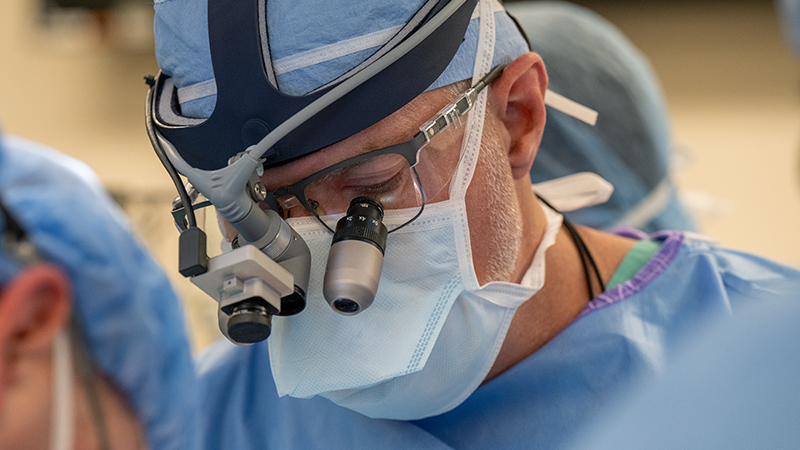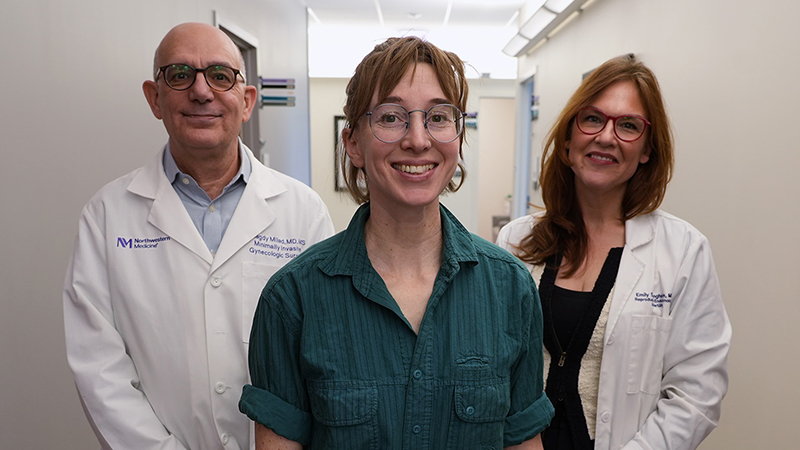A Team Approach to Lung Blood Clots
Teamwork Helps Ensure a Quick Response to Pulmonary Embolism
Published December 2022
Mary, a Chicago-based attorney, was working at home when she started experiencing shortness of breath. She had a few meetings throughout the day and found it hard to catch her breath while talking.
“I thought to myself, ‘that's interesting’ and just kept on working,” says Mary, who was recovering from a fractured bone in her heel and using crutches for a few weeks. Once she was able to start walking again in a brace, she noticed some pain in her calf, but attributed it to the use of her calf muscle again.
By late afternoon, Mary knew something was wrong and called her husband who was at his office in a suburb near Northwestern Medicine Lake Forest Hospital.
“We made a plan that I would drive to Lake Forest Hospital and he would meet me there,” says Mary.
Before she got into her car, Mary fainted. After regaining consciousness, she called her husband back to let him know that she could not drive. Her husband arrived home and they left right away for Lake Forest Hospital.
A Quick Diagnosis
The team in the Lake Forest Hospital Emergency Department quickly recognized that Mary was showing signs of pulmonary embolism, which happens when a lung artery is blocked by a blood clot. A CT scan confirmed a large clot in Mary’s main pulmonary artery.
It is a tremendous medical collaboration.— Arif Jivan, MD, PhD
The emergency department physician and on-call pulmonary critical care physician alerted the Pulmonary Embolism Response Team (PERT), which is part of Northwestern Medicine Bluhm Cardiovascular Institute. This multidisciplinary team of experts includes:
- Interventional radiologists
- Cardiologists
- Interventional cardiologists
- Pulmonologists
- Cardiac surgeons
Having a highly specialized team ready to help care for patients with acute pulmonary embolism saves valuable time. Similar teams for patients with this condition are in place throughout Northwestern Medicine.
“The team is trained to rapidly identify, triage and manage patients with a pulmonary embolism who could potentially benefit from a catheter-directed or percutaneous intervention,” says Arif Jivan, MD, PhD, an interventional cardiologist and PERT team co-director at Lake Forest Hospital.
Depending on a patient’s situation, the team is also ready to administer thrombolytic medicines, which can dissolve clots, or perform a surgery.
“With Mary, we needed to intervene right away,” says Dr. Jivan, who was part of the response team when Mary was admitted to the emergency department. “She was requiring large amounts of supplemental oxygen and had blood test evidence that — with this clot causing strain on the lungs and the heart — it was affecting blood flow to the rest of her body.”
Teamwork for Treatment
The care team brought Mary to the cardiovascular catheterization lab where they used a specialized catheter to aspirate (suck out) the blood clot. The minimally invasive procedure was finished in less than one hour while Mary was awake. Within 48 hours of arriving at the emergency department, Mary was headed home.
“Immediately after removal of a significant amount of clot, her heart rate decreased, her oxygen requirement went down and her blood pressure improved,” explains Dr. Jivan.
Dr. Jivan says that Mary’s clot most likely started in her leg while she was recovering from the fractured bone in her foot. Without muscles moving frequently — which keeps blood flowing — blood can pool and clot.
A blood clot in one of the large veins, typically in a leg or arm, is called a deep vein thrombosis. This type of clot can travel to the lungs, which is then called a pulmonary embolism.
Jonathan Cooke, MD, is a Northwestern Medicine critical care medicine specialist. He started the PERT program at Northwestern Medicine Central DuPage Hospital in October 2017 and then at Northwestern Medicine Delnor Hospital in March 2018. “The point of putting this type of team together is not just because these are patients are at high risk, but also because multiple different fields are required to have eyes on all aspects of a patient's clot,” Dr. Cooke says. “It is far more efficient to get everyone talking at the same time.”
At the Northwestern Medicine Bluhm Heart Hospital in Chicago, Interventional Cardiologist Daniel R. Schimmel, MD, and PERT team co-director, says there is at least one patient treated each day for pulmonary embolism. In addition, a response team for patients with high-risk lung blood clots is activated about three times each week. “An acute care physician evaluates the patient and enlists a multidisciplinary team, based on the patient’s needs,” he says.
Follow-Up Care
One week after the blood clot in her lung was removed, Mary was back at work.
“It’s miraculous how you can go from such an unstable and serious condition to feeling like yourself again,” she says.
Mary will continue to be monitored closely by a team of pulmonologists and hematologists at the Northwestern Medicine Pulmonary Clot Clinic in Chicago.
“It is a tremendous medical collaboration — from the acute phase of immediate illness to long-term follow-up,” says Dr. Jivan. “Some patients can have long-term issues with clots in their lungs and may need subsequent procedures. For the most part, if you treat the acute problem, patients do very well long term without anything needing to be done in the future.”
Designed to support patients who received treatment for high-risk blood clots, the Pulmonary Hypertension and Clot Clinic has patients from all over the country. “The chronic thromboembolic pulmonary hypertension (CTEPH) program, led by Michael Cuttica, MD, and designed for patients with long-term problems from acute pulmonary embolism, currently sees patients in person and also through telehealth. Telehealth has allowed us to treat patients throughout the Midwest, and as far as Florida,” says Dr. Schimmel.
Mary says that follow-up care at the Pulmonary Hypertension and Clot Clinic gives her peace of mind.
“As you can imagine, this was a scary time. The follow-up visits are reassuring. I'm used to getting a physical and maybe needing care for a cold or sinus infection, so this was all new to me,” she explains. “Having the support of all these specialists and having this follow-up care coordinated on my behalf takes a big load off my mind.”



